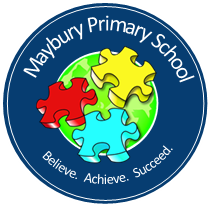Read Write Inc Phonics at Maybury
Our Approach to the Teaching of Reading
Reading is the most important skill we teach at our school and our aim is for every child to be an enthusiastic and confident reader. It enables children to access the full curriculum.
We can achieve this together through:
- using Read, Write, Inc; a program to help your child to read
- encouraging children to develop a love for books by reading to them daily, at home and at school and through listening to them read
- giving children access to a wide range of books at school and at home including books above their current reading level

At Maybury, we use Read Write Inc Phonics (RWI) to give your child the best possible start to their reading. We have put together this guide to show how the RWI program works, together with some useful links. Once your child gains confidence in decoding words, we can begin to concentrate on all the other skills involved in the reading process, especially on comprehension.
What is Read Write Inc?
RWI is a complete phonics program which helps all children learn to read fluently and at speed so they can focus on developing their skills in comprehension, vocabulary and spelling. The program is designed for children aged 4-7 but we continue teaching RWI to children beyond the age of 7 if they still need support with their reading. RWI was developed by Ruth Miskin and more information on this can be found at: https://www.ruthmiskin.com/en/find-out-more/parents/
An Overview of the Program
EYFS
In EYFS, the children will learn the sounds, how to read them in words and how to write them down.
Reading
- The children learn 44 sounds and the corresponding letters/letter groups using simple picture prompts
- They learn to read words using Fred talk and sound blending
- They read from a range of story books and non-fiction books matched to their phonic knowledge
- They develop their comprehension skills through discussion and paired activities based on the books they read.
Writing
- The children learn to write and form the letters/letter groups which represent the 44 sounds with the help of fun phrases
- They learn to write/spell words by using Fred fingers
- They learn to build sentences by practising sentences out loud before they write.
In part of every lesson, children work in pairs when they:
- check correct pronunciation of sounds
- blend sounds to make words
- practise sounds and words they already know as well as the new sound
- ask and answer questions
This paired work ensures maximum participation from each child.
